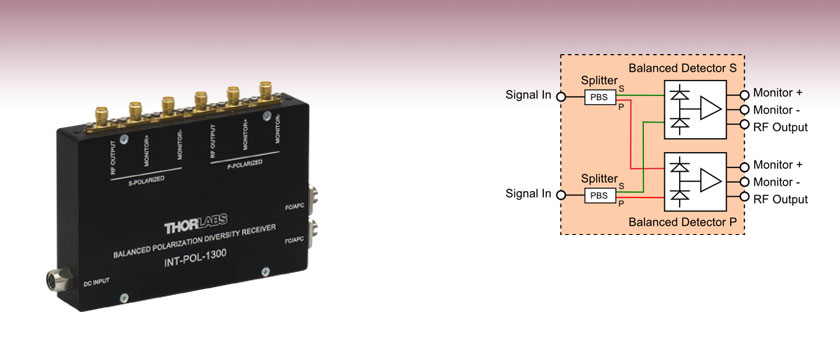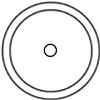Polarization-Dependent Balanced Detector

- Polarization-Dependent Balanced Detection
- Ultra Low Noise
- Excellent Common Mode Rejection
INT-POL-1300
Splitting Input for
Independent Balanced
Detection of S and P SOPs

Please Wait
| Balanced Detector Selection Guide |
|---|
| Balanced Detectors with Fast Monitor Output |
| Large-Area Balanced Amplified Detectors |
| Suitable for OCT |
| Compact Balanced Amplified Detectors |
| Compact Balanced Detectors |
| OCT Balanced Detectors with Fast Monitor Output |
| Auto-Balanced Detector with Avalanche Photodiodes |
| Polarization-Dependent Balanced Detector |
| Item # | INT-POL-1300 |
|---|---|
| Optical Parameters | |
| Wavelength Rangea | 1270 - 1350 nm |
| Fiber Type | Corning SMF28 |
| Optical Connectors | FC/APC |
| Extinction Ratio (PBS) | 22 dB |
| Max. Input Power 1300 nm | 20 mW |
| Electrical Parameters | |
| Detector Material/Type | InGaAs / PIN |
| Detector Wavelength Range | 800 - 1700 nm |
| Typical Max. Responsivity | 1.0 A/W |
| Output Bandwidth RF Output | DC - 15 MHz |
| Output Bandwidth Monitor Output | DC - 5 MHz |
| Transimpedance Gain | 50 x 10³ V/A |
| Conversion Gain Monitor Outputs | 5 V/mW |
| Saturation Power | 80 µW @ 1300 nm |
| Electrical Output /Impedance | SMA, 50 Ω |
| DC Offset | ±10 mV |
| Power Supply | ±12 V @ 250 mA (100/120/230 VAC, 50 - 60 Hz, Switchable) |
Features
- Compact Design
- Integrated Signal Detection with Active Aliasing Filter
- Fast Monitor Outputs for External Polarization Adjustment
- Excellent Common Mode Rejection
- Matched Lengths of S and P Paths
The INT-POL-1300 is an integrated pair of balanced detectors that are used to analyze the S and P States of Polarization (SOP) of two input signals independently. This compact system is designed for polarization sensitive optical coherence tomography (OCT) applications, but it can be used in any application where the difference between two signals has to be analyzed with high sensitivity.
Functionality of Balanced Receivers
The S and P polarization states of the input are split using polarizing beamsplitters (PBS). The split inputs are directed into two balanced detectors, one for each SOP. These balanced photodetectors operate in the same manner as our PDB400 Series of OCT Balanced Detectors, they subtract the two optical input signals from each other resulting in the cancellation of common mode noise. This allows small changes on the signal path to be extracted from the interfering noise floor for each SOP.
Noise Reduction
These receivers are comprised of two balanced photodetectors and an ultra-low-noise, high-speed transimpedance amplifier. The advanced design allows an improved matching of the two balanced photodetectors to achieve an excellent common mode rejection, leading to better noise reduction. Furthermore, the balanced detectors have active low-pass filters to prevent aliasing effects and to suppress out of band noise effectively.
Connectors
Optical signals are coupled to the photodiodes via two FC/APC input connectors. The unit has 6 electrical SMA output connectors 3 per polarization state, i.e. 3 for the S and 3 for the P polarization state. One of these 3 outputs provides the balanced signal and the other two are the power monitor outputs. The monitor outputs enable the control of the input power levels for each detector separately and can be used to adjust the input SOPs for each channel independently. The device is powered via an ±12 V DC input connector.
Packaging and Power Supply
The unit is housed in a rugged, shielded aluminum enclosure. The unit is powered from a ±12 Volts DC power supply which is included.
Thorlabs also offers Fiber-Based Interferometers, which feature an integrated balanced detector.
RF Output
SMA Female

Monitor (+/-)
SMA Female

| Posted Comments: | |
Priyanka Dey
(posted 2021-09-02 15:34:09.27) Can u provide INT-POL-1300 for wavelength upto 1550 nm. soswald
(posted 2021-09-07 07:38:10.0) Dear Priyanka,
thank you for your feedback. We can offer a custom version of our INT-POL-1300 optimized for 1550 nm. I have contacted you directly to discuss your application in more detail. Brian Wilmer
(posted 2021-04-06 17:59:50.84) Please make a silicon version as well as high-speed! This is a fantastic product, taking the place of the analyzation optics too. Absolutely perfect for monitoring polarization changes. Almost does all of the work for you. MKiess
(posted 2021-04-09 11:12:34.0) Dear Brian, thank you for your feedback. Your ideas and feedback help us to constantly improve our products and develop new items. We are glad to hear that you are satisfied with this detector. We have a few options to make custom designs of the Polarization-Dependent Balanced Detector. If you have any special requests, please contact our technical support. jjurado
(posted 2011-07-14 16:51:00.0) Response from Javier at Thorlabs to acable: The limitation of the operating wavelength range of the INT-POL-1300 module is determined by the bandwidth of the two polarization beamsplitters used. The central wavelength of these beamsplitters is 1310nm, with a +/-40 nm operating bandwidth.(See page 6 of the manual: http://www.thorlabs.com/Thorcat/19300/19384-D02.pdf). We may be able to offer versions of the INT-POL module for other wavelength ranges. You can contact techsupport@thorlabs.com for details. acable
(posted 2011-07-14 15:50:14.0) Please explain why the two wavelength ranges in the specifications table, the 1270 to 1350 nm is much narrower than the 800 to 1700 nm given for the detector. Is the PBS the limiting component, can this be changed by using a broadband beamsplitter. julien
(posted 2010-10-08 06:15:56.0) A response from Julien at Thorlabs: Yes this is technically possible. Please contact techsupport@thorlabs.com if you would need a quotation. user
(posted 2010-10-06 19:35:25.0) IF it was available with 1550 PBSs. jens
(posted 2009-12-23 08:16:06.0) A reply from Jens at Thorlabs: thanks for pointing this out, we have corrected the pricing on the web. It is now the same as in the catalog. alee
(posted 2009-12-22 18:42:19.0) hi,
i noticed that this product is listed as $2400 in the new v20 catalog but $3250 on the website. can you please confirm pricing.
thanks,
-anthony |
 Products Home
Products Home








 Polarization-Dependent Balanced Detector
Polarization-Dependent Balanced Detector